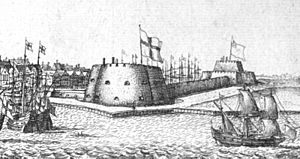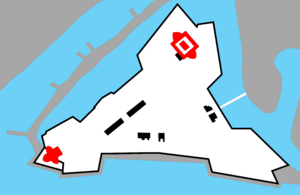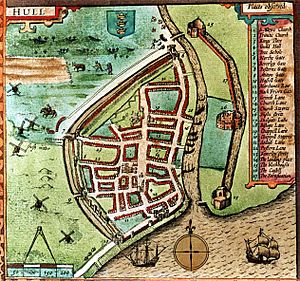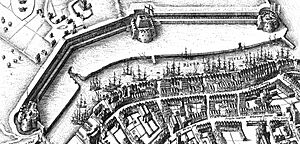Hull Castle facts for kids
Quick facts for kids Hull Castle |
|
|---|---|

South Blockhouse (centre) and Hull Castle (right) viewed from the sea, Wenceslas Hollar, mid-17th century
|
|
| Coordinates | 53°44′36″N 0°19′36″W / 53.74339°N 0.326679°W |
| Type | Device Fort |
| Site information | |
| Condition | Only foundations remain |
| Site history | |
| Materials | Brick and stone |
| Demolished | 1801, 1864 |
| Events | English Civil War |
Hull Castle was a strong fort built in Kingston upon Hull, England. It was an artillery fort, meaning it was designed to hold many cannons. King Henry VIII had it built in 1542 to protect the eastern side of the River Hull. It was part of his "Device programme," a plan to build forts all along England's coast to guard against attacks from France.
The castle had two large, curved sections called bastions and a rectangular tower in the middle, known as a keep. Two smaller forts, called blockhouses, stood nearby. These blockhouses also had curved bastions for guns. A long wall, called a curtain wall, and a moat connected the castle to the blockhouses. Building these defenses cost a lot of money, about £21,056, and used materials from old monasteries that King Henry VIII had closed down. In 1553, the town of Hull took over looking after these defenses, which led to many arguments with the King's government about who should pay for repairs.
Over the years, the castle and blockhouses were sometimes used as prisons, especially for Catholic people who refused to follow the new English Church rules. These prisoners often faced very tough conditions. The forts were actively used during the English Civil War in the 1640s, when Hull was attacked. Later, in 1681, King Charles II rebuilt Hull's eastern defenses, creating a much larger fort called the Citadel. Hull Castle and the South Blockhouse became part of this new design. The North Blockhouse was eventually pulled down in 1801. The Citadel, including the old castle and blockhouse parts, was finally demolished in 1864 to make way for new docks. Today, only the foundations remain, and archaeologists have studied them.
Contents
History of Hull Castle
Why Was Hull Castle Built?
Threats from Other Countries
Hull Castle was built because of big disagreements between England, France, and the Holy Roman Empire during the last years of King Henry VIII's rule. Before this, England usually let local lords and towns handle their own coastal defenses. While there were some small forts, most of England's defenses were not very strong.
In 1533, King Henry VIII broke away from the Pope and the Catholic Church. This made the Holy Roman Emperor, Charles V, very angry because Henry had divorced his aunt. In 1538, France and the Holy Roman Empire became allies against England, and the Pope encouraged them to attack. It looked like England would be invaded.
King Henry's Plan
To prepare, Henry VIII ordered a plan called a "device" in 1539. This plan gave instructions for building forts along the English coast to defend against invasion. The immediate danger passed, but it returned in 1544 when France threatened to invade again, this time with help from Scotland. So, Henry issued another "device" to make England's defenses even stronger.
How Was Hull Castle Built?
Hull Castle was built to protect the town of Kingston upon Hull from a possible French attack. It was also meant to show the King's power, as the people of Hull had rebelled against him in 1536. When Henry visited Hull in 1541, he saw that the town's defenses were strong on the north and west sides, but very weak on the east, especially around the harbor.
So, in early 1542, King Henry ordered a major new defense system. John Rogers, a military engineer, was brought to England to design it. The plan included a main castle and two large blockhouses on the east side of the River Humber. The King himself probably helped with some of the design ideas.
Building Materials and Costs
Sir Richard Long and Michael Stanhope were in charge of the building work. Many workers were needed, including masons, carpenters, and plumbers. Some building materials came from monasteries that Henry VIII had recently closed. Stone and lead were taken from Meaux Abbey, and more stone came from other religious buildings in Hull. Bricks were even made on site using ten kilns. By December 1543, the project had cost £21,056, which was a huge amount of money back then.
Castle Design
The castle was made of brick and stone. It had two large, curved sections called bastions on its east and west sides. In the middle was a three-story rectangular keep, which was about 66 feet by 50 feet. The outer walls were 19 feet thick and had openings for hand-guns and two levels for artillery. A moat surrounded the castle.
The two-story blockhouses were also built from brick and stone. Each had a square tower in the middle and three curved bastions for guns. Their walls were 16 feet thick and sloped to help deflect cannon fire. The design of these bastions was new for England, but they weren't perfect for defending all angles. A long, strong wall, about 900 meters long and 12 feet high, connected the blockhouses and the castle. This wall also had a wet moat on its eastern side.
Life at the Castle
Early Years and Maintenance
After the castle was built, Sir Richard Long and Michael Stanhope were put in charge. At first, many soldiers were stationed there, but most were sent away by the end of 1542. Still, the castle and blockhouses were expensive to keep up. In 1553, the town of Hull agreed to take over their maintenance in exchange for £50 a year from the King. The town promised to keep the forts in good condition.
However, arguments soon started between the King's government and the town. The government claimed the town wasn't doing enough to maintain the forts. Surveys in the 1570s showed that the gun platforms were in bad shape and the ditches were blocked. Queen Elizabeth I even provided trees to help with repairs. Fears of a Spanish invasion in 1588 led to more repairs, but the arguments over who should pay continued in court. The town argued that the original building materials were poor and that they had spent a lot of money on repairs.
Prisoners at the Forts

From 1577 onwards, Hull Castle and the blockhouses were used to hold Catholic people who refused to attend Protestant church services. Sometimes, as many as 16 prisoners were held at once. The ground floor of the South Blockhouse was often used, and conditions were very bad. Records show that the quarters would flood at high tide, making the ground wet and muddy. When there was another scare about a Spanish invasion in 1597, the prisoners were temporarily moved for safety.
The English Civil War and Beyond
Arguments about maintaining the forts continued into the 1600s. The town of Hull said the £50 grant was not enough and wanted to use money from royal taxes to help. A report in 1601 even said the castle was "militarily useless" and had not been looked after for many years. Despite this, the town did carry out some repairs.
Around 1627, the mayor of Hull built an extra gun platform near the South Blockhouse to protect against possible Spanish and French attacks. By 1634, the North Blockhouse had 24 cannons, the castle had 29, and the South Blockhouse had 24. Catholic prisoners continued to be held in the forts, often treated poorly by the guards.
The Sieges of Hull
When the English Civil War began in 1642, Hull supported Parliament against King Charles I. Hull was attacked by the King's forces in July 1642. The South Blockhouse may have helped drive away a Royalist ship. In 1643, the mayor of Hull, Thomas Raikes, suspected the governor was planning to give the town to the King. So, Parliament's troops took control of the castle and blockhouses.
Another siege of Hull happened in 1643. During this time, the area east of the castle and blockhouses was flooded on purpose to create extra protection. In September, part of the North Blockhouse accidentally exploded, killing five men.
After the War
The fighting caused a lot of damage to the forts. After the war, repairs were ordered. The North Blockhouse needed £1,500 worth of work, Hull Castle £300, and the South Blockhouse £220. Even after the war, the forts were kept in use, holding both prisoners of war and political prisoners.
When King Charles II returned to the throne in 1660, the army was reduced. A small group of soldiers stayed in Hull to guard the weapons. Surveys showed the South Blockhouse was in good condition, the castle was poor, and the North Blockhouse was "ruinous." Some materials from the North Blockhouse were supposed to be used for repairs, but they were stolen.
For many years, the defenses were neglected. In 1681, a military engineer named Sir Martin Beckman found them in very bad shape. The North Blockhouse was completely ruined, the South Blockhouse needed major repairs, and the moat was filled with mud. The castle continued to be used as a prison for Catholic recusants.
The Citadel
The King decided to build a new, much larger fort called the Hull Citadel on the eastern side of the river. This new fort would include the old castle and the South Blockhouse. Sir Martin Beckman designed it, and the work cost over £100,000 between 1681 and 1690. The South Blockhouse was repaired and strengthened, becoming the south-west corner of the Citadel. The castle was built into the north corner. Parts of the old curtain wall were pulled down, and the moat was filled in. By 1699, the castle itself no longer held guns, but the South Blockhouse still had some, though they were not working well.
Later Years and Demolition

Hull Castle and the South Blockhouse continued to be used as part of the Citadel during the 1700s and early 1800s. During the Napoleonic Wars, the Citadel was heavily repaired. The South Blockhouse was changed to store naval supplies, and the castle became an armory, holding thousands of weapons. The North Blockhouse and the remaining parts of the old curtain wall were in ruins by 1766. The North Blockhouse was finally demolished between 1801 and 1802.
By the 1800s, many docks had grown up around the Citadel. The Citadel remained a military site until 1848, but new military technology made it outdated. In 1858, there were ideas to turn the site into a public park. However, the Citadel, including Hull Castle and the South Blockhouse, was demolished in 1864 to make room for more docks.
What Remains Today?
Since 1969, archaeologists have been studying the area. The foundations of the Citadel, which were too big to remove in the 1800s, were found during city rebuilding work in 1987. Archaeological digs have also happened at the sites of the castle and the South Blockhouse. The foundations of these buildings are now protected under UK law as an Ancient Monument.
During excavations in 1997, an iron cannon called a "portpiece" was found at the South Blockhouse site. This weapon, now known as "Henry's Gun," is one of only four such guns from that time period still existing in the world. It is now on display at the Hull Museums. It was likely made for Henry VIII or came from the Netherlands. By 1681, it was old-fashioned and was probably thrown away when the Citadel was built.





